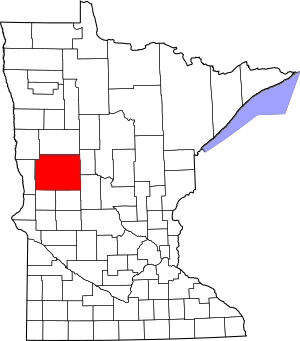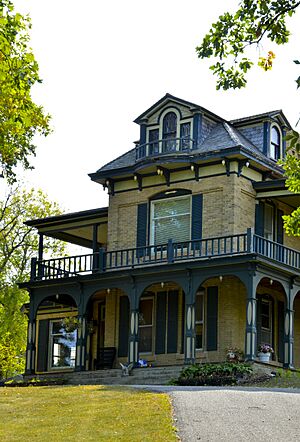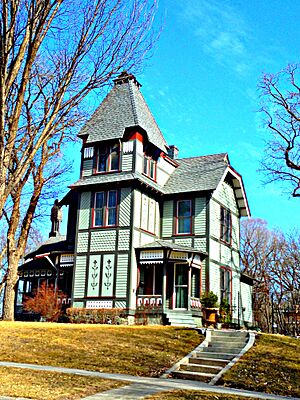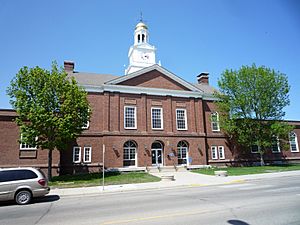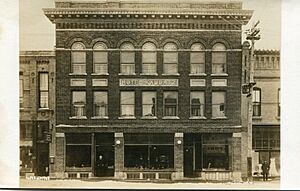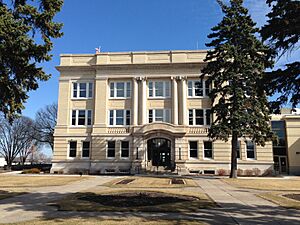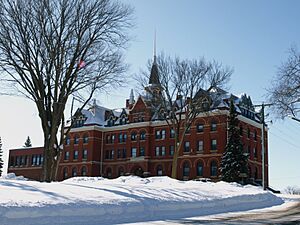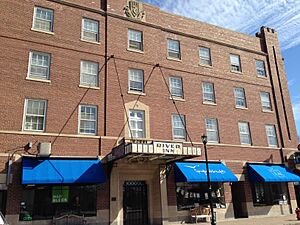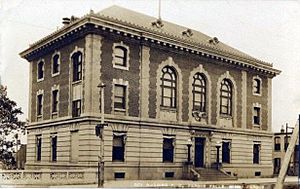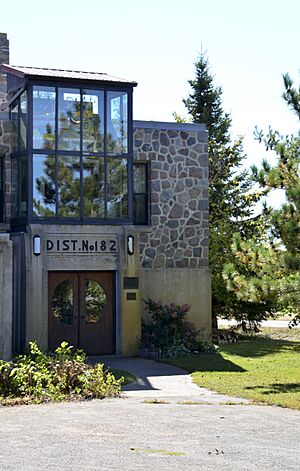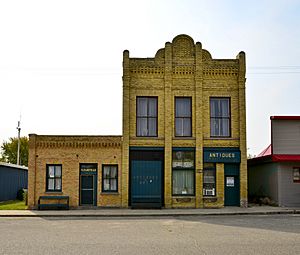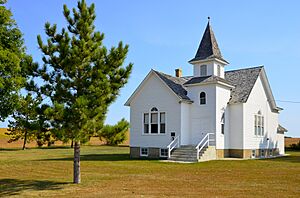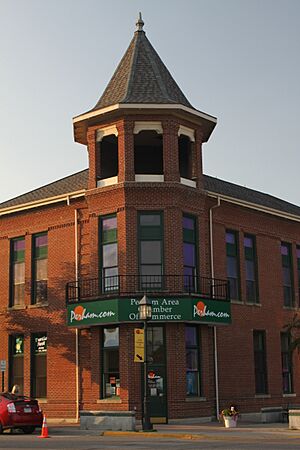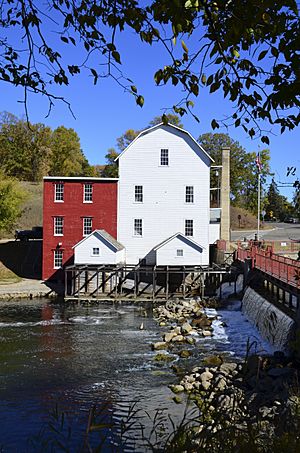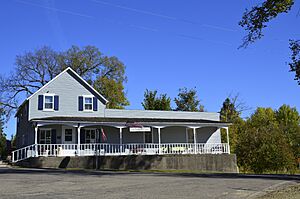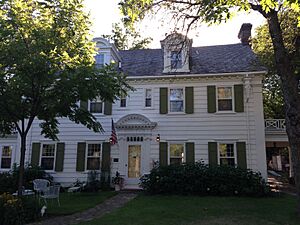National Register of Historic Places listings in Otter Tail County, Minnesota facts for kids
Did you know that many old buildings and places are super important because of their history? In Otter Tail County, Minnesota, there are lots of cool spots that are officially recognized as special. These places are listed on the National Register of Historic Places. It's like a special club for buildings, parks, and sites that tell important stories about the past.
This list includes 28 amazing places in Otter Tail County. They are all protected because they help us understand how people lived and what happened long ago. Some of these places are old houses, some are public buildings, and others are even ancient Native American sites! Let's explore some of these historic treasures.
Contents
- Historic Buildings in Fergus Falls
- Barnard Mortuary: A Unique Style
- O.A.E. Blyberg House: Italianate Beauty
- C.C. Clement House: Stick-Eastlake Design
- Fergus Falls City Hall: Like Independence Hall
- Hotel Kaddatz: A Grand Old Hotel
- Otter Tail County Courthouse: A Place of Law
- Park Region Luther College: A School's History
- River Inn: A Hotel for the Courthouse
- United States Post Office and Courthouse
- Historic Sites and Mills
- Craigie Flour Mill Historical Marker: A Mill's Memory
- District No. 182 School: A WPA Project
- Elizabeth Village Hall and Jail: Town History
- People's Union Church: A Church by Women
- Perham Village Hall and Fire Station: Community Hub
- Phelps Mill: A Working Mill and Park
- Prospect House: A Transformed Inn
- Ancient Sites and Earthworks
- Former Historic Listings
- Images for kids
Historic Buildings in Fergus Falls
Fergus Falls is a city with many historic buildings. It's like a living museum!
Barnard Mortuary: A Unique Style
The Barnard Mortuary was built in 1930. It has a cool style called Mission Revival architecture. This style often uses smooth stucco walls, arched openings, and red tile roofs, making it look a bit like old Spanish missions.
O.A.E. Blyberg House: Italianate Beauty
The O.A.E. Blyberg House in Pelican Rapids was built in 1884. It's a brick house designed in the Italianate style. Imagine a fancy house with tall, narrow windows and a low-pitched roof with wide eaves. That's often what Italianate looks like!
C.C. Clement House: Stick-Eastlake Design
In Fergus Falls, the C.C. Clement House from 1882 is a great example of Stick-Eastlake architecture. This style is known for its decorative wooden patterns on the outside, almost like sticks glued onto the house. It was designed by a famous architect named Charles N. Daniels.
Fergus Falls City Hall: Like Independence Hall
The Fergus Falls City Hall was built in 1928. It's designed in the Georgian Revival style, which means it looks like buildings from the 1700s, especially those from the American colonies. It was even made to look a bit like the famous Independence Hall!
Hotel Kaddatz: A Grand Old Hotel
The Hotel Kaddatz in Fergus Falls opened in 1915. It's a beautiful building in the Renaissance Revival style. This style often brings back ideas from the grand buildings of the Italian Renaissance, with strong, classic shapes. George Hancock was the architect who designed it.
Otter Tail County Courthouse: A Place of Law
The Otter Tail County Courthouse was built in 1922. It's a grand building made of brick and limestone in the Beaux-Arts style. This style is known for being very formal and grand, often used for important public buildings. It was designed by Buechner & Orth.
Park Region Luther College: A School's History
The Park Region Luther College building, built in 1901, is a great example of Romanesque architecture. This style uses strong, round arches and heavy stone or brickwork, making buildings look very solid and impressive. Today, this building is home to Hillcrest Lutheran Academy.
River Inn: A Hotel for the Courthouse
The River Inn in Fergus Falls was built in 1929. It mixes Georgian and Gothic Revival styles. It was built right across from the federal courthouse to serve people visiting there.
United States Post Office and Courthouse
Also in Fergus Falls, the United States Post Office and Courthouse was completed in 1912. This building served as both a place to send mail and a court of law. It's another important example of the architecture from that time.
Historic Sites and Mills
Beyond just buildings, some places are important because of what happened there or what they represent.
Craigie Flour Mill Historical Marker: A Mill's Memory
Near Otter Tail Township, you can find the Craigie Flour Mill Historical Marker. This marker was built in 1940 in a Rustic Style, which means it looks natural and fits into the landscape. It marks the spot of an old gristmill from 1870, where grain was ground into flour.
District No. 182 School: A WPA Project
Near Underwood, the District No. 182 School was built in 1940. It's a Moderne style school made of split-stone. This school was built by the Works Progress Administration (WPA), a government program that created jobs during the Great Depression.
Elizabeth Village Hall and Jail: Town History
The Elizabeth Village Hall and Jail was built in 1898. This brick building served as the town's main office and even had a small jail. It's a great example of a small town's public buildings from that era.
People's Union Church: A Church by Women
In Scambler Township, the People's Union Church from 1915 is very special. It was a non-denominational church, meaning it wasn't tied to one specific religion, and it was actually started and run by women! This was quite unique for its time.
Perham Village Hall and Fire Station: Community Hub
The Perham Village Hall and Fire Station was built in 1906. This brick building served as the town's main office and housed the fire department. It was designed by Fremont D. Orff.
Phelps Mill: A Working Mill and Park
Near Underwood, Phelps Mill is a fantastic historic site. It's an 1889 water-powered gristmill that used to grind different types of grains. Today, it's part of a county park, and you can still see the old mill building. The area around it, called the Phelps Mill Historic District, also includes an 1891 general store and a 1902 miller's house.
Prospect House: A Transformed Inn
In Battle Lake, the Prospect House is a beautiful example of Georgian Revival architecture. It started as an inn in 1887 and was changed in 1929 to look like older American buildings. Now, it's a museum!
Ancient Sites and Earthworks
Some of the oldest and most mysterious places on the list are ancient sites.
Fort Juelson: A Historic Fort and Mounds
Near Tordenskjold, Fort Juelson is a hilltop site with a very interesting history. It has ancient burial mounds from the Woodland period, which was a time long ago when Native Americans lived in this area. In 1876, settlers built a sod fort here because they were worried about attacks. Today, it's a county park.
Maplewood Site: Ancient Habitation
The Maplewood Site near Pelican Rapids is a place where people lived a very long time ago, between 650 and 900 AD, and again between 1450 and 1650 AD. Archaeologists study sites like this to learn about early human life.
Morrison Mounds: Ancient Burial Mounds
Near Battle Lake, the Morrison Mounds are a group of ancient mounds built around 500 to 200 BCE (that's before the common era!). These mounds are important archaeological sites that tell us about the early cultures of the region.
Orwell Site: Woodland Period Mounds
The Orwell Site near Fergus Falls has 12 mounds from the Middle or Late Woodland period. Four of these mounds are even surrounded by an earthwork, which is a large mound of earth built by people. These sites give us clues about ancient communities.
Former Historic Listings
Sometimes, a historic place might be removed from the National Register. This usually happens if the building is moved or changed a lot, so it no longer has its original historic look or location.
Henry G. Page House
The Henry G. Page House in Fergus Falls was an 1870 Italianate style house. It was removed from the list in 1987 because it was moved in 1977.
E. J. Webber House
The E. J. Webber House in Fergus Falls was an 1896 Queen Anne style house, designed by Omeyer & Thori. It was removed from the list in 1992 because it was moved in 1991.
Images for kids


